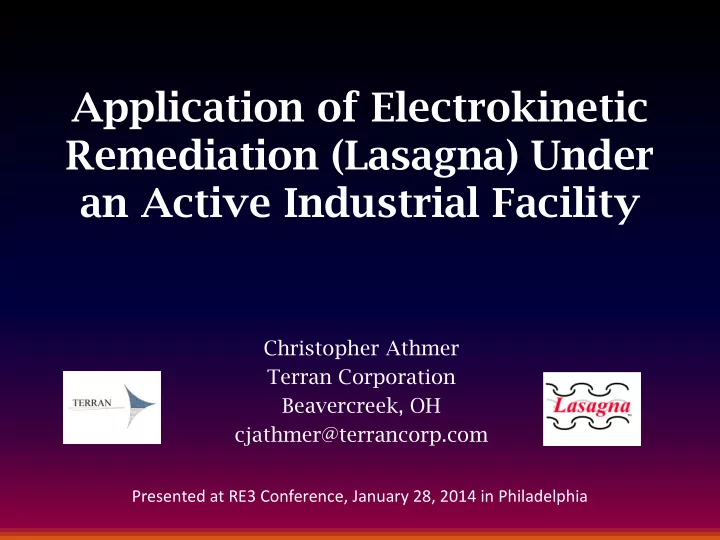

Application of Electrokinetic Remediation (Lasagna) Under an Active Industrial Facility Christopher Athmer Terran Corporation Beavercreek, OH cjathmer@terrancorp.com Presented at RE3 Conference, January 28, 2014 in Philadelphia
Site Conditions • Low permeable soils consisting of lacustrine clay deposits to a depth of 70-90 feet bgs. • Water table 2-7 feet bgs. • Soil and groundwater contaminated with TCE (several DNAPL zones) and other solvents from previous industrial activity. • Plumes located around and under active industrial buildings resulting in VI pathway • 3 rd Party now owns the site – negotiations between client, site owner and state regulators
RCRA Program • RCRA Facility Investigation – 2003-2005 – Soil and groundwater testing indicated 3 contaminated areas, 2 required corrective action • Corrective Measures Study – 2006 – Recommended Lasagna systems for source treatments in Area-1 and Area-2 – MNA for plumes
3- Areas of Contamination
RCRA Program (cont) • Corrective Measures Implementation – Active remediation (Lasagna) operations October 2008 – December 2011 – Groundwater use restrictions – Site use restrictions
Remediation Goals • Protect human health and safety • Reduce direct contact risks in sources areas and inhalation risks in source areas and indoor air • Mass removal in source areas, followed by MNA • Minimize impacts to facility and production during installation and operation of Lasagna
What is Lasagna? • Electrokinetic remediation: applying a DC electric field through planar electrodes • Invokes electroosmosis and electromigration to mobilize contamination • Soil warming through resistive heating (up to 100 C) which helps mobilize pure phase TCE
Makeup Rectifier Shed Water Sump Tank 5’ Pore Water Movement Toward Center Cathode Anode Cathode Anode Steel plate electrode TCE Contamination
Makeup Rectifier Shed Water Sump Tank 5’ Pore Water Movement Toward Center Cathode Anode Cathode Anode + + - Steel plate electrode TCE Contamination
Makeup Rectifier Shed Water Sump Tank 5’ Pore Water Movement Toward Center Cathode Anode Cathode Anode + + - Steel plate electrode TCE Contamination
Makeup Rectifier Shed Water Sump Tank 5’ Pore Water Movement Toward Center Cathode Anode Cathode Anode + + - Steel plate electrode TCE Contamination
Makeup Rectifier Shed Water Sump Tank 5’ Pore Water Movement Toward Center Cathode Anode Cathode Anode + + - Steel plate electrode TCE Contamination
Makeup Rectifier Shed Water Sump Tank 5’ Pore Water Movement Toward Center Cathode Anode Cathode Anode + + - Steel plate electrode TCE Contamination
Makeup Rectifier Shed Water Sump Tank 5’ Pore Water Movement Toward Center Cathode Anode Cathode Anode + + - Steel plate electrode TCE Contamination
Makeup Rectifier Shed Water Sump Tank 5’ Pore Water Movement Toward Center Cathode Anode Cathode Anode + + - Steel plate electrode TCE Contamination
Principles of EK
+/- of EK + Independent of pore size or - Slow (cm/day rates) hydraulic conductivity - Consumes electrodes + Useful in low permeability or - Influenced by large heterogeneous soils convective gradients + Extremely thorough – works - High installation costs on the pore level - Need to manage stray current + Relatively efficient in clay - Relatively unknown + Treatment is done in-situ + Low operation costs + Straight forward scale up
Lasagna Design • Anode at east/west boundaries, cathode at center • Pore water and contamination migrate toward the central cathode • Contamination is reduced by treatment zones
Lasagna Installation • Electrodes of steel plate and wickdrain, side by side to make effective planar electrode rows • Treatment rows, installed parallel to electrodes and spaced 5 feet apart consisted of 50% ZVI in kaolin clay slurry • Emplacements are direct push so no waste soil or spoils to manage and minimal exposures to contamination • EO water is recycled by gravity • All emplacements, wiring and plumbing installed below grade
Lasagna Operation • Large DC rectifier supplied up to 200 volts and 600 amp to Area-1 • Smaller DC rectifier supplied up to 200 volts and 400 amps to Area-2 • Soil temperature (resistive heating) was maintained at 80-90°F • Periodic soil sampling monitored performance • Average DC power delivered was 75kW for Area-1 and 15kW for Area-2
Area-1 Remediation Plan Loading docks
Area-2 Remediation Plan Recycle Roll-off
Site Prep • Existing pavement/blacktop was removed, crushed and placed back as working surface • 480V 3-phase power was brought in for rectifier feed • Utility barn in each area served as rectifier shed with DAQ systems and cable modems
Area-1 Lasagna Performance Average Concentration (ug/kg) at Soil Sampling Events Performance Performance Verification Area-1 Sep-09 Jul-10 May-11 Reductions Number of samples 16 16 44 TCE Avg 11,929 6,501 2,887 76% cis-DCE Avg 2,796 810 1,398 50% VC Avg 116 41 33 72% Statistical results from within Lasagna areas only
Area-2 Lasagna Performance Average Concentration (ug/kg) at Soil Sampling Events Performance Performance Verification Area-2 Sep-09 Jul-10 Jul-12 Reductions Number of samples 8 8 24 TCE Avg 93,249 83,860 15,908 83% cis-DCE Avg 28,093 5,750 10,566 62% VC Avg 699 396 627 10% Statistical results from within Lasagna areas only
Conclusions • Mass removal targets met – >76% removal in Area-1 Lasagna footprint – >83% removal in Area-2 Lasagna footprint • Direct contact risk-based targets were met in all treated areas
Conclusions (cont) • Indoor air sampling results remain stable well below risk thresholds • Groundwater trends are steady or decreasing across the site • Facility was able to maintain full production during installation and operation of Lasagna systems • 5-year review lead to continued GW and IA monitoring with reduced sampling plans
Recommend
More recommend